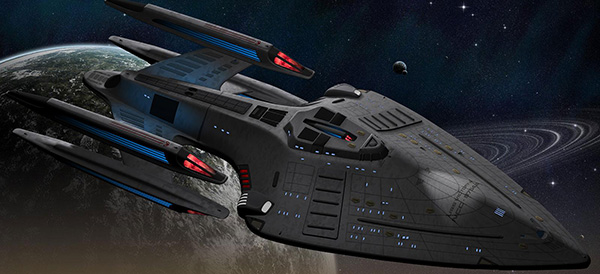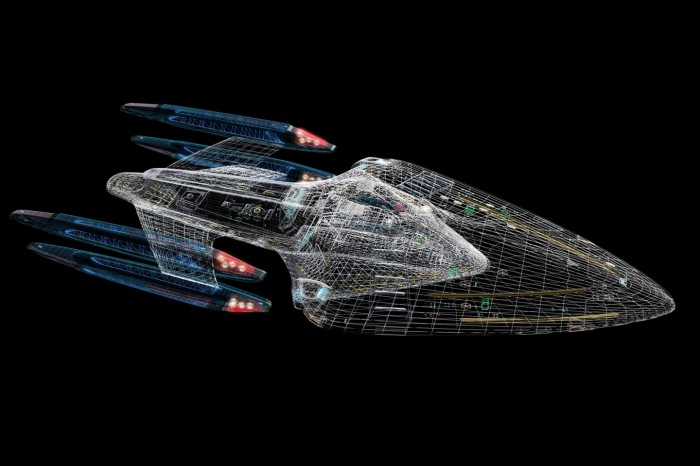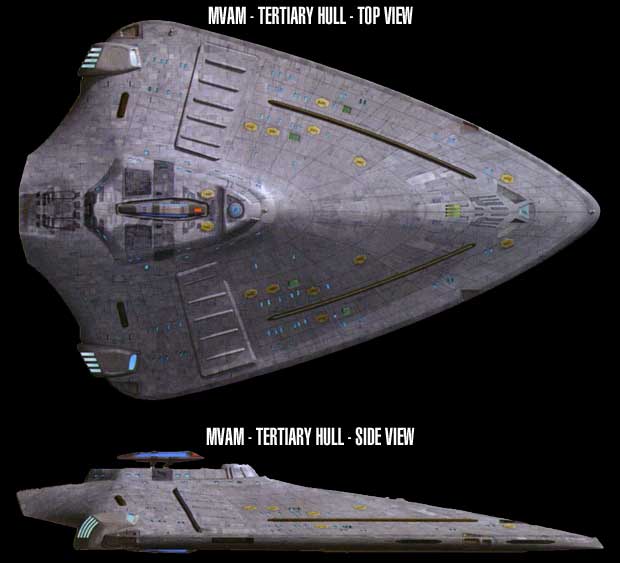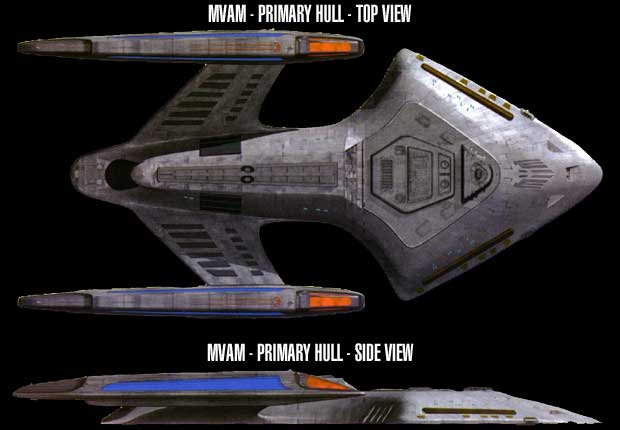Specifications - U.S.S. Victory NCC-9754A
Summary
Technical Specifications for the U.S.S. Victory NCC-9754A
General
| Class | Prometheus | |
| Role | Attack Cruiser | |
| Duration | 80 years | |
| Time Between Refits | 3.5 years | |
| Time Between Resupply | 7 Years |
Dimensions
| Length | 415 meters | |
| Width | 163 meters | |
| Height | 64 meters | |
| Decks | 15 | |
| Mass (Metric Tons) | 2,100,000 |
Personnel
| Officers | 24 | |
| Enlisted Crew | 144 | |
| Emergency Capacity | 275 |
Speed
| Cruise Speed | 8 | |
| Maximum Speed | 9.975 | |
| Emergency Speed | 9.985 for 1 hour |
Weapons & Defensive Systems
| Shields & Sensors | Regenerative shield system, total capacity 3,915,000 TeraJoules Heavy Duranium/Tritanium Double hull plus 18 cm Ablative armor High level Structural Integrity Field Standard level Structural Integrity Field |
|
| Weapon Systems | Type X Phaser Array (14): The Prometheus class utilizes a Type X array system. The 14 arrays are all Type-X, intended as the new standard emitter. Each array fires a steady beam of phaser energy, one after another, and the forced-focus emitters discharge the phasers at speeds approaching .986c (which works out to about 182,520 miles per second - nearly warp one). The phaser array system automatically rotates phaser frequency with each pulse and attempts to lock onto the frequency and phase of a threat vehicle's shields for shield penetration. Phaser Array Output: Each phaser array takes its energy directly from the impulse drive and auxiliary fusion generators. Individually, each type X -emitter can only discharge approximately 10,000 TW (Terrawatts). However, several emitters (usually two) fire at once in the array during standard firing procedures, resulting in a discharge approximately 20,000 TW. Phaser Array Range: Maximum effective range is 300,000 kilometers. Fore (4) & Aft (2) Torpedo Launchers Type: Type-6, Mark-XXV photon torpedo, capable of pattern firing as well as independent launch. Independent targeting once launched from the ship, detonation on contact unless otherwise directed by the tactical officer. Payload: 55 torpedo casings (45 torpedoes, 10 probes). Range: Maximum effective range is 3,500,000 kilometers. TRACTOR BEAM Type: Multiphase subspace graviton beam, used for direct manipulation of objects from a submicron to a macroscopic level at any relative bearing to the Prometheus class. Each emitter is directly mounted to the primary members of the ship's framework, to lessen the effects of isopiestic subspace shearing, inertial potential imbalance, and mechanical stress. Output: Each tractor beam emitter is built around three multiphase 15 MW graviton polarity sources, each feeding two 475-millicochrane subspace field amplifiers. Phase accuracy is within 1.3 arc-seconds per microsecond, which gives superior interference pattern control. Each emitter can gain extra power from the SIF by means of molybdenum-jacketed wave-guides. The subspace fields generated around the beam (when the beam is used) can envelop objects up to 920 meters, lowering the local gravitational constant of the universe for the region inside the field and making the object much easier to manipulate. Range: Effective tractor beam range varies with payload mass and desired delta-v (change in relative velocity). Assuming a nominal 15 m/sec-squared delta-v, the multiphase tractor emitters can be used with a payload approaching 2,330,000 metric tonnes at less than 2,000 meters. Conversely, the same delta-v can be imparted to an object massing about one metric ton at ranges approaching 30,000 kilometers. |
|
| Armament | Sensor Systems specifications Long Range Full EM/Multi-Spectral Scanning: 2500 light-years High Resolution Range: 850 light-years Medium Resolution Range: 185 light-years Full Spectrum EM/Quantum Navigational Deflector Dish Array Astrometric Scanning/Mapping/Analysis Sensor Arrays: 50,000 light-years Impulse Engine specifications Sub light Propulsion System: 2 Subatomic Unified Energy Impulse Engines Impulse Reactors: 8 Impulse Reactor Fuel: Deuterium Transporter specifications Number of Systems: 7 Personnel Transporters: 3 (Transporter Rooms 1-3) Max Payload Mass: 900kg (1,763 lbs) Max Range: 40,000 km Max Beam Up/Out Rate: Approx. 100 persons per hour per Transporter Cargo Transporters: 2 Max Payload Mass: 800 metric tons. Standard operation is molecular resolution (Non-Lifeform). Set for quantum (Lifeform) resolution: 1 metric ton Max Beam Up/Out Rate (Quantum Setting): Approx. 100 persons per hour per Transporter Emergency Transporters: 2 Max Range: 15,000 km (send only) {range depends on available power} Max Beam Out Rate: 100 persons per hour per Transporter (300 persons per hour with 4 Emergency Transports) Communications Systems specifications Intra Ship: voice and data Standard Communications Range: 30,000 - 90,000 kilometers Standard Data Transmission Speed: 18.5 kiloquads per second Subspace Communications Speed: Warp 9.9997 Warp Engine specifications Warp Core Reactor: M/ARA Class IX Propulsion System: 2 24 coil low distortion Warp Nacelles Fuel (Matter Injector): Deuterium Regulator: Dilithium crystal Fuel (Antiproton Injector): antimatter Fuel Replenishment: Bussard ramjet Collectors Computer specifications Number of computer cores: Two. The primary computer core is accessed in the control room on Deck 5 in amidships for maximum protection. It covers five decks and extends from Deck 2 to Deck 5. The Auxiliary core is located on Deck 10 and extends down to Deck 12, covering three decks. It is fed by two sets of redundant EPS conduits as well as primary power. Type: The AC-15 series computer core is built under contract for the Prometheus class vessel by Krayne Systems, an independent contractor based on Bynar. The structure of the computer is similar to that of most other supercomputing systems in use by Federation vessels with stack segments extending through the ship forming trillions of trillions of connections through the processing and storage abilities of modern isolinear chips. Cooling of the isolinear loop is accomplished by a regenerative liquid helium loop, which has been refit to allow a delayed-venting heat storage unit for "Silent Running.” For missions, requirements on the computer core rarely exceed 45-50% of total core processing and storage capacity. The rest of the core is utilized for various scientific, tactical, or intelligence gathering missions - or to backup data in the event of a damaged core. Bio-Neural Gel Packs: Referred to typically as BNGs, Bio-Neural Gel Packs are a new innovation in shipboard data processing and routing. Mounted at strategic locations along the ODN pathways, each BNG consists of an artificial bio-fluid that allows transmission of neural signals. The heart of the BNG is a packet of neural clusters, grown copies of strands similar to those found in the brains of sentient beings. These clusters give the ship’s computer ‘instinctive’ data processing and routing ability as well as allowing the ship’s computer to utilize ‘fuzzy logic’ to speed up probability calculations much as a living, breathing entity would. LCARS Acronym for Library Computer Access and Retrieval System, the common user interface of 24th century computer systems, based on verbal and graphically enhanced keyboard/display input and output. The graphical interface adapts to the task, which is supposed to be performed, allowing for maximum ease-of-use. The Prometheus class operates on LCARS build version 4.5 to account for increases in processor speed and power, limitations discovered in the field in earlier versions, and increased security. UNIVERSAL TRANSLATOR All Starfleet vessels make use of a computer program called a Universal Translator that is employed for communication among persons who speak different languages. It performs a pattern analysis of an unknown language based on a variety of criteria to create a translation matrix. The translator is built in the Starfleet badge and small receivers are implanted in the ear canal. The Universal Translator matrix aboard Prometheus class starships consists of well over 100,000 languages and increases with every new encounter |
Auxiliary Craft
| Shuttlebays | 1 | |
| Shuttles | 4 Type-9 Medium Short-Range Shuttlecraft 2 Type-6 Medium Short-Range Shuttlecraft 1 Type-8 Cargo Shuttle 2 Type-18 Shuttlepods 2 Work Bee Maintenance Pods 1 Aerowing Integrated Craft |
|
| Attack Fighters | Valkryie-Class Enhanced Operation Vessel (6) |
Design History
| Design History | The Prometheus is the culmination of several separate research projects, which have been combined into one prototype test bed. Starfleet has long recognized that, all other factors being even, vessels with high maneuverability can gain a significant combat advantage. The physics of warp drive dictate that for a given engine capacity the least massive vessel will have the greatest maneuverability - but minimizing vessel size is at odds with the large number of scientific and diplomatic functions which a Starship must be able to perform. One obvious solution to this problem was to design ships that are able to configure themselves for the mission at hand, but the non-military nature of Starfleet gave research in this area a relatively low priority. However, the Galaxy class did incorporate some of these ideas in that the saucer section was built to be easily separated and re-attached without outside support. Without the bulk of the saucer the star drive section was much more maneuverable, in theory giving it a significant combat advantage over a saucer-equipped Galaxy. In practice, however, this operation is somewhat unwieldy on the Galaxy class and leaves the saucer (which does not have an independent warp drive) extremely vulnerable to attack. In addition, the saucer section contains the Galaxy's two longest phaser arrays and can provide a significant reserve of power from its fusion reactors. The Galaxy class has therefore not used this capability very often. In 2359 Starfleet initiated a research project intended to explore the possibility of a true multi-section vessel. The requirement called for a vessel able to separate into at least two independent sections, each with a fully functional warp drive of its own. One would be capable of launching an attack with almost the full ships weaponry, at high speed and maneuverability. The other, comprising the scientific, diplomatic and accommodation sections, would clear the area at high warp carrying the civilian complement. Much of the technology being developed for the Intrepid class project was included in this design, with the result that the theoretical model finalized in 2363 bore a close resemblance to the Intrepid herself. In 2364 Starfleet was considering moving to a production basis with the multi-section Starship. However, during this year contact with the Romulans was re-established when the USS Enterprise-D encountered a Warbird at the Neutral Zone. Since the Warbird appeared to outgun the Enterprise - then Starfleet's most powerful ship - by a considerable margin Starfleet was confronted with what appeared to be a powerful and aggressive enemy. As part of their response Starfleet requested a complete re-design of the multi-section starship. The new requirement called for an almost totally re-designed vessel; the ship would be in three sections, each of which would have an independent warp core and drive system. The scientific and diplomatic sections were removed in favor of increased armament and power for the weapons. During the development Starfleet also encountered both the Borg and the Dominion, both hostile and powerful enemies. This led to an ever-accelerating effort to turn the new ship into a pure combat vessel; much technology from other projects was put into what was now dubbed the "multi-vector attack Starship". This came most especially from the Sovereign project - in place of the Type VIII phaser arrays that the original ship had shared with the Intrepid class, the Type XII phaser arrays from the Sovereign project were included. The shield system was massively upgraded and, in light of the subsequent Borg attack, closely based on the auto-modulating shields of the Sovereign. The advanced warp engine design also included many elements of the Sovereign class, while the ablative armor, high capacity structural integrity fields and quantum torpedo tubes developed for the Defiant project were also included. This technology combined to make the new Starship one of the most massively armed and armored vessels of its size ever contemplated, let alone built. The small size combined with incredible speed and maneuverability when in multi-vector mode; when the prototype USS Prometheus was launched in late 2373 she was thought to have a combat capacity an amazing nine times that of the equally-sized Intrepid class, while her Type XII phasers made her a formidable foe for any vessel in the alpha quadrant. The power of the Prometheus was graphically demonstrated when the ship was stolen by rogue operatives of the Romulan Tal'shiar in 2374. Although the prototype was still in the test phase, she was able to inflict devastating damage on a Nebula class ship and withstand a combined attack by two Defiant class Escort vessels, an Akira class cruiser and two Romulan D'Deridex Class Warbirds. In the same battle she used multi-vector assault mode to destroy one of the two Romulan Warbirds with ease. The performance of the Prometheus during this accidental live-fire trial has exceeded all expectations for the ship. The ability to pack firepower little short of a Sovereign class into a ship the size of an Intrepid class offers the prospect of a huge increase in Starfleet's potential combat capability. With Starfleet loosing ground against the Dominion, this could prove to be of vital importance. Starfleet has decided to complete the evaluation as rapidly as possible, and a decision to press ahead with full series production is expected very soon. 2375: On May 3rd 2375 the USS Prometheus NX-59650 is officially commissioned by Starfleet during a brief Ceremony. During which the Ships Plaque is put in pride of place and Captain Byron Bladestorm takes command of the ship and the USS Prometheus is ordered to the Dominion lines. In 2378 the second Prometheus Class ship the USS Archangel NCC-74913 under the command of Captain Darious Van Basstin is completed and assigned to the Delta Quadrant Task Force stationed at Deep Space 12. In early 2380 the Multi-Layered Shielding System(M.L.S.S.) was developed and added to the USS Prometheus and the Prometheus class, the M.L.S.S. itself consists of 3 Layers which absorb the impact from Phaser fire or Torpedoes, it works in conjunction with the Ablative Hull Armour and acts as the First line of defense for the ship when the Shields are either compromised or have failed due to excessive damage. In late 2380 the old Type XII Phaser Arrays were removed and replaced by the New more powerful Type XX Phaser Arrays, later in a major overhaul the 3 original Warpcores was also removed and replaced by 3 New Next-Gen G3 Warpcores which are 3 times more powerful than the originals and allows the Prometheus to sustain it's top speed of 9.99 for a longer 48 hours and it's maximum top speed of 9.999 for 24 hours which is double her original capabilities. The New Warpcores also gave the Prometheus 3 times the power for other things such as Impulse Engines, Shields and Weapons which gives the Prometheus the battle capabilities of twice that of the standard Prometheus and Sovereign class and little short of the DQTF Flagship the Dark Raven which also has the Next-Gen G3 Warpcore, difference being the Dark Raven's G3 is larger than the Prometheus but lacks it special ability of being able to become 3 seperate and fully working warpcores. The Multi-Layered Shielding System(M.L.S.S.) Layer 3 - The outermost layer manipulates graviton polarity in a way not typical to shields, creating a graviton flux disruption that prevents many know designs of threat tractor beams from locking on to the vessel. This layer also incorporates transport inhibitor technology, helping prevent an enemy from transporting aboard. Layer 2 - The middle layer incorporates automatic rotation of frequency and modulation with meta-phasics, which absorbs enemy fire, spreads it out along the shield. This shield sends data on what type of weapon is used and what frequency and phase the weapon uses. Once this is analyzed, the computer can automatically configure shield to have the same frequency as the incoming weapon, but to different modulation, which dramatically increases shield efficiency. Layer 1 - The innermost shield layer is a multi-phaseic shield. Based on standard regenerative shielding, this is the ship's last shielded line of defense, once this is gone the ships only defence is the Ablative Hull Armor. The key to this layer is its ability to 'wave' while in a state of temporal flux. This technology was developed in part by the crew of USS Voyager and the Mannheim Research Station. Instead of a standard oval bubble, this layer 'ripples' or waves (like the surface of water) while in a state of temporal flux. This dramatically increases protection against weapons such as the Hellfire, Chronaton, and Transphaseic Torpedoes while at the same time helping protect the ship from temporal anomalies. The design of the M.L.S.S. was modified just prior to its entering service, in 2376, in order to increase effectiveness against both high-energy tractor beams and phased polaron particles, measures clearly aimed at the Borg and Dominion respectively. Under normal operation the shield modulation frequencies are under the control of the ships computer system, which continually evaluates incoming weapons fire and automatically re-modulates the shields to give the most effective possible defense. It is thought that this system, in conjunction with transport inhibitor technology, will also enable the shield system to prevent beam-through by Borg and Dominion transporter technology. The Multi-Vector Assault Mode(M.V.A.M.) The most Advanced Tactical feature of this Class is the Multi-Vector Assault Mode(M.V.A.M.), in this mode the ship splits into three separate, fully Independent, Warp Capable, sections. The ship is capable of Multi-Vector Assault Mode (MVAM, pronounced em-vam), in which the vessel splits into three smaller warships, each capable of independent warp flight and fully armed. |





.jpg)